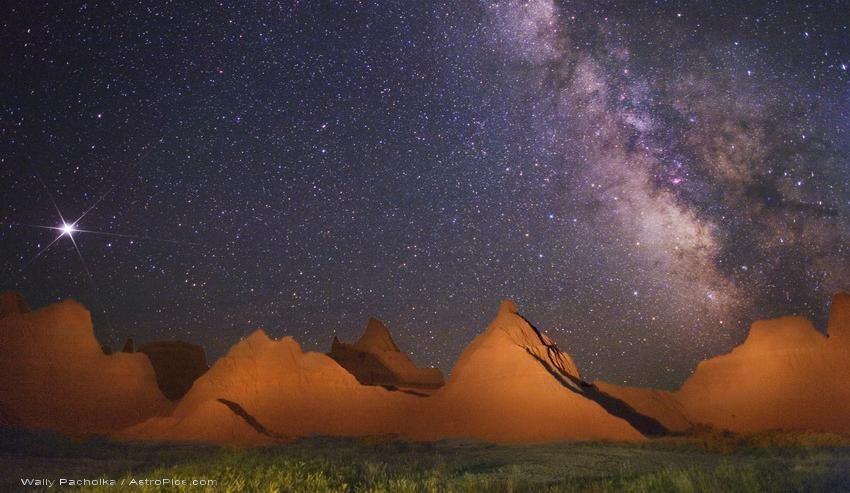Photo by Wally Pacholka / AstroPics
“This park is larger than all of the other National Park Service units in the Midwest combined,” notes Badlands National Park’s chief of interpretation, Jennie Albrinck. “We have a great diversity of stories that converge here — the fossils, the prairie grasses and wildlife, Lakota history, pioneer history, and homesteading. It’s all here waiting to be explored.”
She’s right: with nearly 250,000 acres of mixed-grass prairie and ancient fossil beds, Badlands National Park should be on the must-see list for every adventurer, especially fossil lovers. The park offers an amazingly diverse topography that was once home a collection of animals that is hard to imagine today: saber tooth cats, rhinos, camels, three-toed horses, and a large variety of sea life all once called this area home.
In fact, the White River Badlands contain the largest known assemblage of mammal fossils from the late Eocene and Oligocene periods. The specimens found here have contributed significantly to the science of vertebrate paleontology since the first discovery by Dr. Hirma Prout in 1846.
Significant finds continue in the park today. In fact, just a few years ago, a seven-year-old park visitor named Kylie found a fossil near the visitor’s center. When she reported it to the park rangers, their investigation identified her find as an exceptionally rare and well-preserved saber tooth cat fossil. Additional surveying turned up even more samples, and the area is now known as Saber Site.
In addition to the bird, reptile, and mammalian fossils, there are marine fossils from an ancient sea that covered the region some 70 million years ago during the Cretaceous period. Samples found in the Pierre Shale and Fox Hills Formations include ammonites, nautiloids, fish, marine reptiles, and turtles.
The spectacular fossils preserved within the White River Badlands have been studied extensively for more than 175 years and are featured prominently in museum collections throughout the world. The park also boasts a working Fossil Preparation Lab. Located in the Ben Reifel Visitor Center, this active paleontological laboratory gives visitors the chance to watch paleontologists at work and learn more about the continuing scientific discoveries.
If fossils aren’t your thing, you might be interested in one of the many day hikes available through the park. Trails range from easy to strenuous, so there’s something for everyone. Two highlights include the view of the White River Valley from the top of the strenuous Notch Trail and the magnificent vista at the end of The Door Trail, an easy .75-mile hike the terminates through “the Door” – the appropriately named break in the 100-mile long wall that creates a natural barrier in the park.
A final must-see: The night sky over Badlands National Park is simply stunning. Summer night sky viewing is offered at the Cedar Pass Campground Amphitheater on Friday – Monday nights. On any clear night, visitors you’ll see more than 7,500 stars, and views include not only galaxies but also star clusters, nebulae, planets, and moons. Look closely, and you’ll also see fly-overs by numerous satellites and the International Space Station.
After the evening ranger program, stay to enjoy the spectacular night sky through telescopes provided thanks to funding from Celestron and Badlands Natural History Association.
Getting there: The park is about 3 miles south of I-90 at S. Dak. 240, 75 miles east of Rapid City and 27 miles west of Kadoka. In many ways, getting there can be half the fun. Before heading out, be sure to spend a little time reviewing the fun and quirky roadside attractions found at Travel South Dakota.
A few cautionary notes regarding your time at Badlands National Park. The Badlands can, at times, live up to its name. The weather can turn dangerous very quickly, so be sure to know where you and be prepared at all times. Some key tips:
- Always carry water! Rangers recommend two quarts per person per two-hour hike.
- A hat and sunglasses are strongly encouraged, as well as rain gear since weather conditions can change rapidly.
- Wear sturdy boots or shoes to protect your feet from cactus spines.
- Keep a distance of at least 100 yards from all wildlife encountered during your hike. If wildlife reacts to your presence at all, you are too close.

